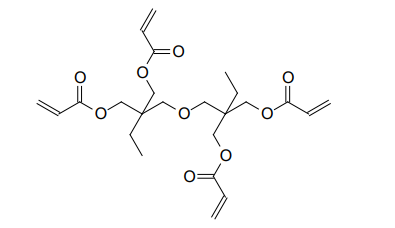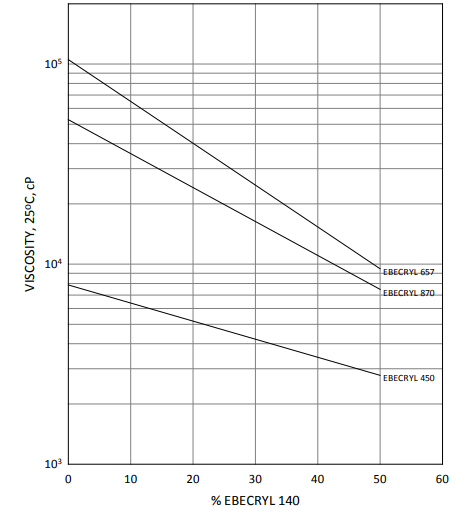Enhanced TDS
Identification & Functionality
- Blend
- No
- CASE Ingredients Functions
- Chemical Family
- Chemical Name
- Function
- Reactive Diluent
- Product Code
- MITM00354
- Single Ingredient
- Yes
- Synonyms
- Bistrimethylolpropane tetraacrylate, Ditrimethylolpropane tetraacrylate, E 140
- Technologies
- Product Families
- Chemical Structure

Features & Benefits
Applications & Uses
- Coating End Applications
- Compatible Polymers & Resins
- Cure Method
- Ink & Toner End Applications
- Markets
- Applications
- Product Applications
EBECRYL® 140 is a reactive diluent that is compatible with a wide range of acrylated resins used in UV/EB curing applications. Effective levels of EBECRYL® 140 typically range from 10% to 30%, depending on the application. In lithographic inks and varnishes it is quite effective in adjusting viscosity while maintaining or improving cure response and physical properties. The high functionality of EBECRYL® 140 provides increased crosslink density in UV/EB cured coatings, which can help improve gloss, hardness, and durability.
- Processing Highlights
EBECRYL® 140 is characterized by:
- Light color
- Good cure response
- Low irritancy
UV/EB cured products based on EBECRYL® 140 are characterized by the following performance properties:
- Flexibility while retaining hardness
- High abrasion resistance
- Good chemical resistance
The actual properties of UV/EB cured products also depend on the selection of other formulation components such as oligomers, additives and photoinitiators.
Properties
- Physical Form
Technical Details & Test Data
- Viscosity Reduction
Graph I illustrates the viscosity reduction of several EBECRYL lithographic ink vehicles when blended with EBECRYL® 140.

Packaging & Availability
Principal Information
- Group Principal Number
- S000001
- Principal
Storage & Handling
- Storage and Handling Conditions
- Care should be taken not to expose the product to high temperature conditions, direct sunlight, ignition sources, oxidizing agents, alkalis or acids. This might cause uncontrollable polymerization of the product with the generation of heat.
- Storage and handling should be in stainless steel, amber glass, amber polyethylene or baked phenolic lined containers. Procedures that remove or displace oxygen from the material should be avoided.
- Do not store this material under an oxygen free atmosphere. Dry air is recommended to displace material removed from the container. Wash thoroughly after handling. Keep container tightly closed. Use with adequate ventilation.
Other
- Appearance
- Clear liquid
- Appearance (SDS)
- Liquid
- Color (SDS)
- Colorless to pale yellow
- IATA/ICAO Proper Shipping Name
- Environmentally hazardous substance, liquid, N.O.S.
- IATA/ICAO Technical name (N.O.S.)
- Ditrimethylolpropane Tetraacrylate
- IATA/ICAO UN Number
- UN3082
- IMO/IMDG Proper Shipping Name
- Environmentally hazardous substance, liquid, N.O.S.
- IMO/IMDG Technical name (N.O.S.)
- Ditrimethylolpropane Tetraacrylate
- IMO/IMDG UN Number
- UN3082
- Insoluble in (SDS)
- Water
- Item Number
- Odor (SDS)
- Ester acrylate
- Other Hazards
- Polymerization may occur from excessive heat, contamination or exposure to direct sunlight .
- Protect from Freezing
- Yes
- TDG Canada Proper Shipping Name
- Environmentally hazardous substance, liquid, N.O.S.
- TDG Canada Technical name (N.O.S.)
- Ditrimethylolpropane Tetraacrylate
- TDG Canada UN Number
- UN3082
- Temperature Control
- Yes
- USA/DOT Proper Shipping Name
- Environmentally hazardous substance, liquid, N.O.S.
- USA/DOT Technical name (N.O.S.)
- Ditrimethylolpropane Tetraacrylate
- USA/DOT UN Number
- UN3082
- Application Information
Value Units Test Method / Conditions Dosage (Use Level) 10.0-30.0 % % - Chemical Properties
Value Units Test Method / Conditions Acid Value max. 10.0 mg KOH/g mg KOH/g - Mechanical Properties
Value Units Test Method / Conditions Elongation 2.5 % % UV cured 125 µ thick films Tensile Modulus 225000.0 psi psi UV cured 125 µ thick films Tensile Strength 5300.0 psi psi UV cured 125 µ thick films - Optical Properties
Value Units Test Method / Conditions Color Scale max. 200.0 APHA APHA - Physical Properties
Value Units Test Method / Conditions Density 1.08 g/mL g/mL at 25°C Flash Point min. 100.0 °C °C Setaflash Glass Transition Temperature (Tg) 81.0 °C °C Dynamic Mechanical Analysis (DMA) UV cured, 125μm thick films Molecular Weight 466.0 g/mol g/mol Storage Temperature 39.0-104.0 °F °F Viscosity 800.0-1200.0 mPa.s mPa.s at 25°C - SDS Physical and Chemical Properties
Value Units Test Method / Conditions Boiling Point (SDS) min. 100.0 °C °C Density (SDS) 1.1 g/cm³ g/cm³ Melting Point (SDS) -56.0 °C °C Partition coefficient n-octanol/water (SDS) 4.34 - Vapor Pressure (SDS) max. 1.33 hPa hPa at 20°C Viscosity (SDS) 800.0-1200.0 mPa.s mPa.s at 25°C Volatile Content (SDS) max. 0.3 % % - Shelf Life & Stability
Value Units Test Method / Conditions Shelf Life 0.0 d d
